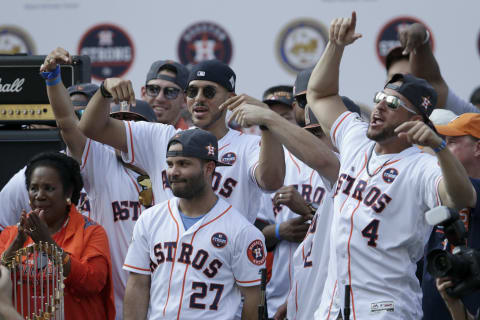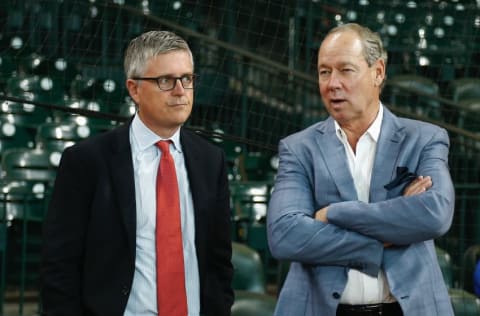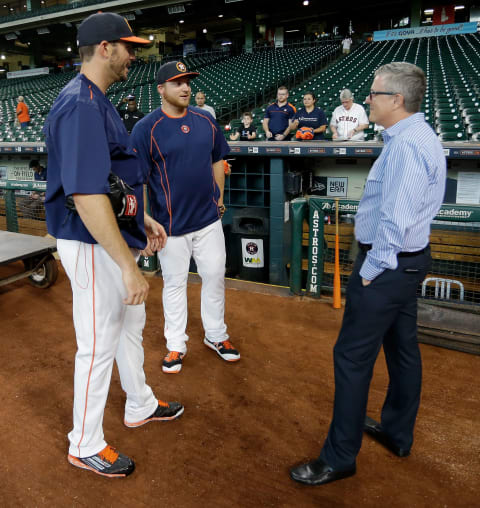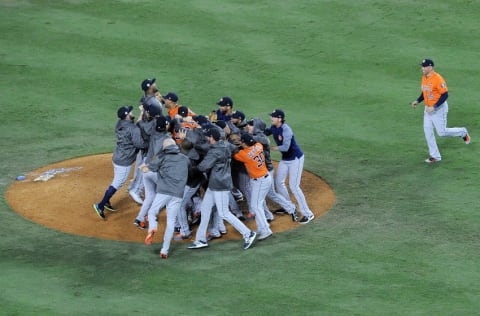Houston Astros: Constructing a Champion


Here’s how the Astros built a winner.
Baseball is all about numbers. The Astros know this better than anyone else. There are infinite stats available everywhere. If you want to know a player’s batting average, it’s out there. What about a pitchers ERA? It’s out there. I’ll throw some numbers out there for you.
$149,964,177.
That’s the Astros total team salary payroll in 2017 per Spotrac.
Seems like a lot, right?This is good for the 15th overall payroll in the MLB for 2017. Unsurprisingly, the heavy-hitter Dodgers are first with a $265 million payroll. Second overall are the Yankees with $224 million and the Red Sox in third with $222 million. And Astros beat all three of those teams to win the championship in reverse order!
In fact, 15th overall is high for the Astros. They were 21st in 2016, 25th in 2015 and last in 2013 and 2014. Astros have had the lowest payrolls in the league for quite some time.
Does money buy championships?
Not always.
This team was built with numbers but not the ones following the dollar sign but was built on Sabermetrics. Jeff Luhnow took over as General Manager for the Astros in 2011 and began work immediately. The Astros got worse under his first few years, but behind the scenes, they actually were getting better. They had three straight 100 loss seasons followed by a 92 loss season in 2014 before making a playoff appearance in 2015. In the 55 year history of this team, they have never lost 100 or more games let alone 3 in a row.

Trust the Process
Attendance was the lowest it’s been since the mid-90s in the Astrodome, and their payroll was the worst in that tenure.
Behind the scenes though, they managed to attain Sig Mejdal a NASA bio-mathematician who studied sleep patterns for astronauts. As of 2012, he serves as the Director of Decisions Sciences for the Houston Astros. He was hired to help the team with analytics and created the STOUT system.
The STOUT system essentially is Stats and Scouts analytics to select players and rejuvenate the farm system. Therefore, he created formulas and analysis based on Bill James, the grandfather of sabermetrics. Little did we know as fans, they were constructing a championship team behind the scenes.
Like I mentioned earlier, baseball has a stat on everything. It’s the most numbers weighted game in all sports mainly due to the inconstancies of the dimensions of all the different ballparks in the Major League. Baseball is no longer about only generating runs and striking opposing batters out to get the win. In fact, teams with little payroll rely on these hidden stats to create wins.
It all starts with the players. One benefit of being at the bottom for so long is higher draft picks, compensation, supplementary picks and waiver priority. The Astros are a young team with an average age of 29 and a homegrown roster.
Putting this team together.
It all started with Jose Altuve being an international signing in 2006. After being sent home for being too short, he returned the next day pleading for an audition. He impressed team officials and signed a contract. He played in the minors for four years before being promoted in 2011. That’s same year. The Astros select George Springer with their first pick of the 2011 draft.
In 2009, they signed Dallas Keuchel in the seventh round. He struggled in the minors and finally had a sub-5.00 ERA before being signed on to the Astros in 2012 only going on to be a Cy Young Award winner in 2015 and World Champion this year.
They snagged Carlos Correa in 2012 with the first overall pick and grabbed Lance McCullers, Jr. in the second round. Derek Fisher and Alex Bregman and Yuli Gurriel were drafted in 2014 and 2015. Yuli Gurriel was signed to a contract in 2016.
This team led all Major League Baseball with production from talent acquired, but they weren’t finished. I mentioned earlier that waiver priority and trades were also a benefactor in constructing a team in last place. They found Marwin Gonzalez in 2011. Joe Musgrove and Chris Devenski in 2012. Brad Peacock in 2013. Also, Evan Gattis was acquired in 2015 from the Braves and Brian McCann in 2016 from the Yankees. Oh, I almost forgot, they traded for some guy named Justin Verlander this year.
Did I miss anybody?

So, now you have the team. How do you make the formulas work?
With the team now built how do you plug in the formulas and create wins? A huge part of sabermetrics are formulas. There are formulas to determine wins, runs created, and efficient defense. Baseball is no longer just spending money on big names and big bats. You can now manufacture wins based on talent and science. That’s huge for teams with small payrolls.
Some of the formulas are as follows.
BABIP – Batting Average on Balls in Play
For instance, manager A.J. Hinch’s infamous “shift.” It’s no secret that the Astros have a soft spot for the shift. While a costly risk, the reward is much greater. In BABIP, you anticipate balls being hit and adjust your fielders to move or “shift” towards the most likely area that ball will be placed. You create more groundball outs, double plays and fly balls out that way.
Teams study their opponents vs. their pitcher vs. their fielders and adjust. The over-shift could be costly as the opposing batter will attempt to drive the ball through the opening where he creates a base hit but when it works, its genius.
RC – Runs Created
First off, you win baseball games with runs. The Astros had 896 runs in 2017 the most runs, and a clear 38 runs ahead of the Yankees who finished in second place with 858.
Batting average isn’t a good enough measurement in this day and age. We need a more mathematical approach. This measures how many runs a player creates. The formula is easy; it’s hits plus walks multiplied by the total bases divided by the at-bats plus walks. RC= (H + BB) x TB / (AB + BB).
WAR (WARP) – Wins above replacement player.
What WAR actually represents is the number of wins this player contributed above what a replacement level hitter, fielder, and pitcher would have done. Well, how is this calculated? You calculate a player’s stats like home runs, walks, strikeouts, stolen bases, BABIP, games played, and their position played and the value scale of their defensive ranking and base-running ability. I won’t bore you with the formula, but you can see it here and try it out for yourself on FanSided’s Believeland Ball.
This will also calculate how many wins a player contributes to the team and their value in millions for payroll purposes. It’s amazing how you can predict and analyze how many wins a player can essentially get you for the team in a single season. The Astros had the highest WAR of any team this year with 50.2. Their batting provided 29.9 WAR, and the pitching delivered 20.2 WAR.
There are many more formulas, metrics, and calculations to determine anything and everything a team needs to know or wants to know about their opponents.

Putting It All Together
Now you have the team you want to roll out for the season plus the analytics on pretty much everything including sleeping patterns, so how do you make it work? That’s what the front office filled with analysts and scientist are for. Talent evaluators scouted these guys for years and measured everything. Furthermore, through acquisitions, payroll and a few trades you now have a roster capable of creating a 101 win season and the first World Series championship for the franchise.
This year was a special season. Even if the Astros didn’t win the World Series, this season is a vindication to sabermetrics, scouting, player development, and passion.
The Future
Can the Astros sustain this method with this group of guys for many years to come? Isn’t that the multi-million dollar question? Currently, we have this team intact for next year barring trades and injuries. Beginning 2019 we will have some free agents and some important decisions to make including Jose Altuve, Justin Verlander, Marwin Gonzalez and George Springer along with some arbitration deals. Essentially, this team as an organization that finally has a great front office to make this machine be a contender for years to come.
Next: Should the Astros renew their pursuit of Zach Britton?
Lastly, they’ve proved this year that they can win despite the middle of the pack payroll and with the right group of guys on the field and in the front office they are on the right track to a dynasty.
**Statistics and information courtesy of Fangraphs, MLB.com, ESPN and Spotrac**